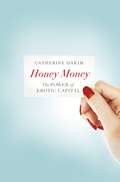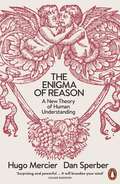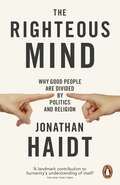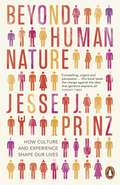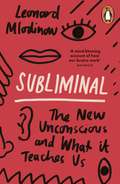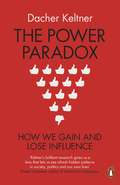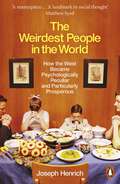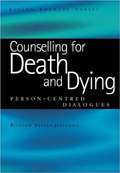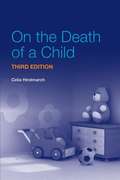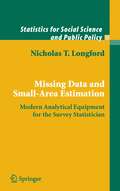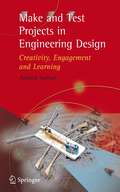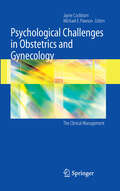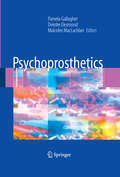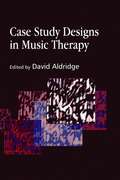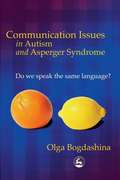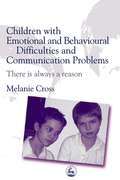- Table View
- List View
Honey Money: The Power of Erotic Capital
by Catherine HakimWhy do some people seem to lead charmed lives? They are attractive, but also lively, friendly and charismatic. People want to be around them. Doors open for them. The answer, this book shows, is in the power of erotic capital - the overlooked human asset that is at the heart of how we work, interact, make money, succeed and conduct our relationships. Catherine Hakim's groundbreaking book reveals how erotic capital is just as influential in life as how rich, clever, educated or well-connected we are. Drawing on hard evidence, she illustrates how this potent force develops from an early age, with attractive children assumed to be intelligent, competent and good. She examines how women and men learn to exploit it throughout their lives, how it differs across cultures and how it affects all spheres of activity, from dating and mating to politics, business, film, music , the arts and sport. She also explores why erotic capital is growing in importance in today's highly sexualised culture and yet, ironically, as a 'feminine' virtue, remains sidelined. Honey Money is a call for us to recognize the economic and social value of erotic capital, and truly acknowledge beauty and pleasure. This will not only change the role of women in society, getting them a better deal in both public and private life - it could also revolutionize our power structures, big business, the sex industry, government, marriage, education and almost everything we do.
The Enigma of Reason: A New Theory of Human Understanding
by Dan Sperber Hugo MercierGUARDIAN BOOKS OF THE YEAR 2017'Original and provocative ... likely to have a big impact on our understanding of ourselves' Steven Pinker'Mercier and Sperber offer a surprising and powerful response to the new orthodoxy propounded by Kahneman and Tversky ... arguing that the supposed flaws of hot, fast, automatic thinking are actually design features which work remarkably well' Julian BagginiReason, we are told, is what makes us human, the source of our knowledge and wisdom. But, if reason is so useful, why didn't it also evolve in other animals? If it is that reliable, why do we produce so much thoroughly reasoned nonsense?In their ground-breaking account of the evolution and workings of reason, Hugo Mercier and Dan Sperber set out to solve this double enigma, taking us on a journey from desert ants to modern scientists, and from Aristotle to Daniel Kahneman. Reason, they argue with a compelling mix of real-life and experimental evidence, is not geared to solitary use, to arriving at better beliefs and decisions on our own. What reason does, rather, is help us justify our beliefs and actions to others, convince them through argumentation, and evaluate the justifications and arguments that they address to us.In other words, reason has evolved to help humans better exploit their uniquely rich social environment. This illuminating interpretation of reason makes sense of strengths and weaknesses that have long puzzled philosophers and psychologists - why reason is biased in favour of what we already believe, why it may lead to terrible ideas and yet is indispensable to spreading good ones. Ambitious, provocative, and entertaining, The Enigma of Reason will spark debate among psychologists and philosophers, and make many reasonable people rethink their own thinking.
The Righteous Mind: Why Good People are Divided by Politics and Religion
by Jonathan HaidtIn The Righteous Mind, psychologist Jonathan Haidt answers some of the most compelling questions about human relationships:Why can it sometimes feel as though half the population is living in a different moral universe? Why do ideas such as 'fairness' and 'freedom' mean such different things to different people? Why is it so hard to see things from another viewpoint? Why do we come to blows over politics and religion?Jonathan Haidt reveals that we often find it hard to get along because our minds are hardwired to be moralistic, judgemental and self-righteous. He explores how morality evolved to enable us to form communities, and how moral values are not just about justice and equality - for some people authority, sanctity or loyalty matter more. Morality binds and blinds, but, using his own research, Haidt proves it is possible to liberate ourselves from the disputes that divide good people.'A landmark contribution to humanity's understanding of itself' The New York Times'A truly seminal book' David Goodhart, Prospect'A tour de force - brave, brilliant, and eloquent. It will challenge the way you think about liberals and conservatives, atheism and religion, good and evil' Paul Bloom, author of How Pleasure Works 'Compelling . . . a fluid combination of erudition and entertainment' Ian Birrell, Observer'Lucid and thought-provoking ... deserves to be widely read' Jenni Russell, Sunday Times
Beyond Human Nature: How Culture and Experience Shape Our Lives
by Jesse J. PrinzIn this provocative, revelatory tour de force, Jesse Prinz reveals how the cultures we live in - not biology - determine how we think and feel. He examines all aspects of our behaviour, looking at everything from our intellects and emotions, to love and sex, morality and even madness. This book seeks to go beyond traditional debates of nature and nurture. He is not interested in finding universal laws but, rather, in understanding, explaining and celebrating our differences. Why do people raised in Western countries tend to see the trees before the forest, while people from East Asia see the forest before the trees? Why, in South East Asia, is there a common form of mental illness, unheard of in the West, in which people go into a trancelike state after being startled? Compared to Northerners, why are people in the American South more than twice as likely to kill someone over an argument? And, above all, just how malleable are we?Prinz shows that the vast diversity of our behaviour is not engrained. He picks up where biological explanations leave off. He tells us the human story.
Subliminal: The New Unconscious and What it Teaches Us
by Leonard MlodinowLeonard Mlodinow, the best-selling author of The Drunkard's Walk and coauthor of The Grand Design (with Stephen Hawking) and War of the Worldviews (with Deepak Chopra) here examines how the unconscious mind shapes our experience of the world, and how, for instance, we often misperceive everything from our relationships with family, friends and business associates, the reasons for our investment decisions, to our own past.Your preference in politicians, the amount of tip you give the waiter-all our judgments and perceptions-reflect the workings of our mind on two levels, the conscious, of which we are aware, and the unconscious, which is hidden from us. The latter has long been the subject of speculation, but over the past two decades scientific researchers have developed remarkable new tools for probing the hidden, or subliminal, workings of the mind. The result of this explosion of research is a new science of the unconscious, and a sea change in our understanding of how the mind affects the way we live. These cutting-edge discoveries have revealed that the way we experience life-our perception, behavior, memory, and social judgment-is largely driven by the mind's subliminal processes and not by the conscious ones, as we have long believed. Employing his trademark wit and his lucid, accessible explanations of the most obscure scientific subjects, Leonard Mlodinow takes us on a tour of this research, unraveling the complexities of the subliminal self, increasing our understanding of how the human mind works, and how we interact with friends, strangers, spouses and coworkers. In the process he changes our view of ourselves and the world around us.
The Power Paradox: How We Gain and Lose Influence
by Dacher KeltnerA revolutionary rethinking of everything we know about powerIt shapes every interaction we have, whether we're trying to get a two-year-old to eat green vegetables or ask for a promotion at work. But how do we really gain power? And what does it do to us?As renowned psychologist Dacher Keltner reveals, the new science of power shows that our Machiavellian view of status is wrong. Influence comes not to those who are ruthless, but to those with socially intelligence and empathy. Yet, ironically, the seductions of success lead us to lose those very qualities that made us powerful in the first place. Keltner draws on fascinating case studies to illuminate this 'power paradox', revealing how it shapes not just companies and elections but everyday relationships. As his myth-busting research shows, power - and powerlessness - distorts our behaviour, affecting whether or not we will have an affair, break the law, drive recklessly or find our purpose in life.In twenty original 'power principles', Keltner shows how we can retain power by maintaining a focus on others. By redefining power as the ability to do good, The Power Paradox turns everything we know about influence, status and inequality upside down.
The Weirdest People in the World: How the West Became Psychologically Peculiar and Particularly Prosperous
by Joseph Henrich'A landmark in social thought. Henrich may go down as the most influential social scientist of the first half of the twenty-first century' MATTHEW SYEDDo you identify yourself by your profession or achievements, rather than your family network? Do you cultivate your unique attributes and goals? If so, perhaps you are WEIRD: raised in a society that is Western, Educated, Industrialized, Rich and Democratic. Unlike most who have ever lived, WEIRD people are highly individualistic, nonconformist, analytical and control-oriented. How did WEIRD populations become so psychologically peculiar? What part did these differences play in our history, and what do they mean for our collective identity? Joseph Henrich, who developed the game-changing concept of WEIRD, uses leading-edge research in anthropology, psychology, economics and evolutionary biology to explore how changing family structures, marriage practices and religious beliefs in the Middle Ages shaped the Western mind, laying the foundations for the world we know today. Brilliant, provocative, engaging and surprising, this landmark study will revolutionize your understanding of who - and how - we are now. 'Phenomenal ... The only theory I am aware of that attempts to explain broad patterns of human psychology on a global scale' Washington Post'You will never look again in the same way at your own seemingly universal values' Uta Frith, Professor of Cognitive Development, University College London
Counselling for Death and Dying: Person-Centred Dialogues (PDF)
by Richard Bryant-JefferiesThis book contains forewords by Sheila Haugh and Grace H Chickadonz respectively - Senior Lecturer Psychotherapy, Centre for Psychological Therapies, Leeds Metropolitan University; Center for Human Encouragement, Rochester, New York, USA. What happens to a person emotionally, psychologically and spiritually when confronted by the reality of the death of a loved one, the impending death of someone close to them, or their own death? As with the other volumes of the "Living Therapy" series, "Counselling for Death and Dying" is composed of fictitious dialogues between clients and their counsellors, and between the counsellors and their supervisors. Within the dialogues are woven the reflective thoughts and feelings of the clients, the counsellors and the supervisors, along with boxed comments on the process and references to person-centred theory. It is intended as much for experienced counsellors as it is for trainees and provides real insight into what can occur during counselling sessions. The book will also be of great value to the many health and social care professionals who, whilst they may specialise in other areas, will find that the issues dealt with in this volume have impact on the work they are doing. For them, the text demystifies what can occur in therapy, and provides useful ways of working that may be used by professionals other than counsellors. 'Richard has a deep understanding of theory and practice and has brought this understanding to this greatly neglected area in person-centred literature. [He] has the talent as a writer to honour the client, the counsellor/therapist, the supervisor and the process in all its intricacies. Richard has produced a book that, to my mind, captures the pain, the joy, the challenge of being with someone bereaved and someone facing death. The book also captures the pain and hurt and confusion of being that person who is bereaved or facing death. ' - Sheila Haugh, in her Foreword. 'What is most striking about the dialogues is the realness of the feelings present in this all too human experience as lived by the clients. What is most beautiful is the relationship of acceptance shared in being in this most intimate place together as client and therapist. The healing that occurs is understandable in the strength of their connectedness. ' - Grace H Chickadonz, in her Foreword.
On the Death of a Child, 3rd Edition (PDF)
by Celia HindmarchThe death of a child - whether during or following birth, through illness, through accident, or through suicide - is one of the greatest challenges families, carers, friends, and the health and social care professionals who support them can face. This book provides professionals with practical advice, resources for further support and reading, and much-needed reassurance that whatever contact they have with the bereaved, and however inadequate they may feel to the task, they can make a difference. With revised material and an entirely new chapter reflecting recent developments in bereavement theory, the third edition of this classic text offers unique insights for professionals with varying levels of experience. From theory and narrative come practical ideas on what to say, what to do, how to behave, how to stay humble in situations where the only real experts are the bereaved themselves, and how professionals can look after themselves in what can be particularly traumatic and upsetting circumstances.
Missing Data and Small-Area Estimation: Modern Analytical Equipment for the Survey Statistician (Statistics for Social and Behavioral Sciences)
by Nicholas T. LongfordThis book evolved from lectures, courses and workshops on missing data and small-area estimation that I presented during my tenure as the ?rst C- pion Fellow (2000–2002). For the Fellowship I proposed these two topics as areas in which the academic statistics could contribute to the development of government statistics, in exchange for access to the operational details and background that would inform the direction and sharpen the focus of a- demic research. After a few years of involvement, I have come to realise that the separation of ‘academic’ and ‘industrial’ statistics is not well suited to either party, and their integration is the key to progress in both branches. Most of the work on this monograph was done while I was a visiting l- turer at Massey University, Palmerston North, New Zealand. The hospitality and stimulating academic environment of their Institute of Information S- ence and Technology is gratefully acknowledged. I could not name all those who commented on my lecture notes and on the presentations themselves; apart from them, I want to thank the organisers and silent attendees of all the events, and, with a modicum of reluctance, the ‘grey ?gures’ who kept inquiring whether I was any nearer the completion of whatever stage I had been foolish enough to attach a date.
Make and Test Projects in Engineering Design: Creativity, Engagement and Learning
by Andrew E. SamuelMake and test projects are used as introductory design experiences in almost every engineering educational institution world wide. However, the educational benefits and costs associated with these projects have been seldom examined. Make and Test Projects in Engineering Design provides a serious examination of the design of make and test projects and their associated educational values. A taxonomy is provided for the design of make and test projects as well as a catalogue of technical information about unconventional engineering materials and energy sources. Case studies are included based on the author’s experience of supervising make and test projects for over twenty-five years. The book is aimed at the engineering educator and all those planning and conducting make and test projects. Up until now, this topic has been dealt with informally. Make and Test Projects in Engineering Design is the first book that formalises this important aspect of early learning in engineering design. It will be an invaluable teaching tool and resource for educators in engineering design.
Psychological Challenges in Obstetrics and Gynecology: The Clinical Management
by Jayne Cockburn Michael E. PawsonThis book empowers the obstetrician-gynecologist to play a key coordinating role, and to communicate effectively with all parties and health workers involved in psychological care. It provides information not typically covered by their training: communication skills, coping and adjustment in pregnancy, and communicating with cancer patients. Easy-to-read with stand-alone chapters, this book covers key aspects of OB/GYN, and addresses areas not covered elsewhere. The book offers topics in psychological care to trainees and specialists in O & G, helps them understand the emotional problems their patients face, and shows them how to undertake psychological care.
Psychoprosthetics
by Pamela Gallagher Deirdre Desmond Malcolm MaclachlanPsychoprosthetics is defined as the study of psychological aspects of prosthetic use and of rehabilitative processes in those conditions that require the use of prosthetic devices. Psychoprosthetics: State of the Knowledge brings together, into one easily accessible volume, the most recent and exciting research and knowledge in this new field
Case Study Designs in Music Therapy
by Denise Grocke Cochavit Elefant David Aldridge Hanne Mette Ridder Ochsner Gudrun AldridgeResearch and clinical work are often perceived as opposites in the field of music therapy. This book shows, for the first time, how these two areas of work can creatively complement one another, proving beneficial to both disciplines. Each chapter is written by a leading researcher and practitioner in the field, and the book covers a wide spectrum of approaches within different settings. Beginning with methodological and musicological approaches to case studies, the book then moves on to more specific topics such as the use of case studies in an interactive play setting and in music therapy with the elderly. Later chapters explore theoretical aspects, looking at a worked example of music and progressive change during therapy, and how case study designs can be used in practice. A must for all professionals working and studying within the music therapy area, this is also an informative and useful book for health researchers.
Case Study Designs in Music Therapy (PDF)
by Cochavit Elefant David Aldridge Denise Grocke Gudrun Aldridge Hanne Mette Ridder Ochsner Tony WigramResearch and clinical work are often perceived as opposites in the field of music therapy. This book shows, for the first time, how these two areas of work can creatively complement one another, proving beneficial to both disciplines. Each chapter is written by a leading researcher and practitioner in the field, and the book covers a wide spectrum of approaches within different settings. Beginning with methodological and musicological approaches to case studies, the book then moves on to more specific topics such as the use of case studies in an interactive play setting and in music therapy with the elderly. Later chapters explore theoretical aspects, looking at a worked example of music and progressive change during therapy, and how case study designs can be used in practice. A must for all professionals working and studying within the music therapy area, this is also an informative and useful book for health researchers.
An Exact Mind: An Artist With Asperger Syndrome (PDF)
by Peter Myers Sally Wheelwright Simon Baron-CohenPeter Myers' intricate and ornately patterned drawings are brought together for the first time in this volume, which is the fascinating result of the collaboration of an artist and two scientists. The beautiful, complex images (included in full-page colour as well as black and white reproductions) serve as a rare window into the precision and exacting creativity of the Asperger mind at work. Peter Myers was diagnosed with Asperger Syndrome in 1996 and his work reflects his stunning ability to plan and to organise visual information, and to embed illusions within his pictures. Peter's brief explanatory captions which accompany the images offer insight into the ways in which he composes his pictures. In the main text of the book, psychologists Simon Baron-Cohen and Sally Wheelwright discuss the work's great psychological significance, demonstrating in accessible language their ground-breaking systemizing theory of how the autistic mind processes information.
Communication Issues in Autism and Asperger Syndrome: Do we speak the same language?
by Olga BogdashinaProviding a theoretical foundation for understanding communication and language impairments specific to autism, Olga Bogdashina explores the effects of different perceptual and cognitive styles on the communication and language development of autistic children. She stresses the importance of identifying each autistic individual's nonverbal language - which can be visual, tactile, kinaesthetic, auditory, olfactory or gustatory - with a view to establish a shared means of verbal communication. She offers an explanation of why certain approaches, for example PECS, might work with some autistic children but not others. Offering real insights, the `What They Say' sections enable the reader to see through the eyes of autistic individuals and to understand their language differences first hand. `What We Can Do to Help' sections throughout the book give practical recommendations on what to do in order to help autistic individuals use their natural mechanisms to learn and develop social and communicative skills. The final chapters are devoted to assessment and intervention issues with practical recommendations for selecting appropriate methods and techniques to enhance communication, based on the specific mode of communication a person uses.
Communication Issues in Autism and Asperger Syndrome: Do we speak the same language? (PDF)
by Olga BogdashinaProviding a theoretical foundation for understanding communication and language impairments specific to autism, Olga Bogdashina explores the effects of different perceptual and cognitive styles on the communication and language development of autistic children. She stresses the importance of identifying each autistic individual's nonverbal language - which can be visual, tactile, kinaesthetic, auditory, olfactory or gustatory - with a view to establish a shared means of verbal communication. She offers an explanation of why certain approaches, for example PECS, might work with some autistic children but not others. Offering real insights, the `What They Say' sections enable the reader to see through the eyes of autistic individuals and to understand their language differences first hand. `What We Can Do to Help' sections throughout the book give practical recommendations on what to do in order to help autistic individuals use their natural mechanisms to learn and develop social and communicative skills. The final chapters are devoted to assessment and intervention issues with practical recommendations for selecting appropriate methods and techniques to enhance communication, based on the specific mode of communication a person uses.
A Practical Art Therapy
by Susan BuchalterIt can be difficult to be spontaneous during every art therapy group. It is helpful to have a resource full of creative and inspiring ideas that can be utilized as needed. This broad-ranging collection of projects injects variety into art therapy sessions. A Practical Art Therapy is written in an easy-to-read format that is filled with practical creative experiences for therapists to use with individuals and groups. Chapters cover various media and methods, including murals, collages, sculpture and drawing, making it easily accessible for even the busiest therapist. Susan Buchalter includes practical art projects using everyday objects, and follows them through with a list of materials needed, a procedure plan and aims of the project. The creative exercises draw on situations and ideas that children and adults can relate to - for example, drawing wishes and goals, sculpting their own stress and creating a collage self-portrait. The author suggests ways of expanding art-making activities, such as drawing to music and creating personal logos. This book is suitable for those new to the arts therapies field, practising art therapists, counselors and social workers.
A Practical Art Therapy (PDF)
by Susan BuchalterIt can be difficult to be spontaneous during every art therapy group. It is helpful to have a resource full of creative and inspiring ideas that can be utilized as needed. This broad-ranging collection of projects injects variety into art therapy sessions. A Practical Art Therapy is written in an easy-to-read format that is filled with practical creative experiences for therapists to use with individuals and groups. Chapters cover various media and methods, including murals, collages, sculpture and drawing, making it easily accessible for even the busiest therapist. Susan Buchalter includes practical art projects using everyday objects, and follows them through with a list of materials needed, a procedure plan and aims of the project. The creative exercises draw on situations and ideas that children and adults can relate to - for example, drawing wishes and goals, sculpting their own stress and creating a collage self-portrait. The author suggests ways of expanding art-making activities, such as drawing to music and creating personal logos. This book is suitable for those new to the arts therapies field, practising art therapists, counselors and social workers.
Psychiatric Aspects of Justification, Excuse and Mitigation in Anglo-American Criminal Law
by Alec BuchananViolent crimes committed by the mentally disordered attract academic and public attention. They raise issues of moral responsibility and public protection. This study systematically analyses the principles underlying those legal and medical devices which enable the courts to make special arrangements for the mentally disordered. Buchanan examines three fundamental precepts in criminal law: justification, excuse and mitigation. A defendant who has been proved guilty can usually have his or her sentence reduced only where one of these three principles applies. The way that the courts interpret notions of responsibility and choice may influence the outcome considerably. For mentally disordered offenders, the matter becomes even more complicated - this is where the psychological and psychiatric aspects of justification, excuse and mitigation come into play. The author combines a jurisprudential analysis of the above with a discussion of current legal provision for mentally disordered offenders in England and America. This thought-provoking book will be of particular interest to a wide range of professionals in the forensic field, as well as to academics specialising in mental health law and the philosophy of psychiatry.
Tics and Tourette Syndrome: A Handbook for Parents and Professionals
by Uttom ChowdhuryThis essential guide to tic disorders and Tourette Syndrome tackles problems faced both at home and at school, such as adjusting to the diagnosis, the effect on siblings and classroom difficulties. Dr Chowdhury offers advice on how to manage symptoms, describing practical techniques such as habit reversal and massed practice and reviewing available medical treatments. In clear, accessible language, this book explains the clinical signs and symptoms of Tourette and related conditions, and their possible causes. Presenting strategies for dealing with associated difficulties, including low self-esteem, anger-management and bullying, this book will be invaluable to parents, teachers, social workers and other professionals.
Tics and Tourette Syndrome: A Handbook for Parents and Professionals (PDF)
by Uttom ChowdhuryThis essential guide to tic disorders and Tourette Syndrome tackles problems faced both at home and at school, such as adjusting to the diagnosis, the effect on siblings and classroom difficulties. Dr Chowdhury offers advice on how to manage symptoms, describing practical techniques such as habit reversal and massed practice and reviewing available medical treatments. In clear, accessible language, this book explains the clinical signs and symptoms of Tourette and related conditions, and their possible causes. Presenting strategies for dealing with associated difficulties, including low self-esteem, anger-management and bullying, this book will be invaluable to parents, teachers, social workers and other professionals.
Children with Emotional and Behavioural Difficulties and Communication Problems: There is always a reason (PDF)
by Melanie CrossChildren and young people with emotional and behavioural difficulties (EBD) are far more likely to have communication problems than their peers. Exploring the ways in which children's language and emotional development are linked, Melanie Cross considers the reasons why behavioural and communication difficulties often occur together. Identifying the common causes of these problems and the reasons why they often go undetected, she provides practical guidelines for assessing communication skills and the complexities of identifying communication problems in children, including children in public care. She shows how improving children's communication can also improve their behaviour and that speech and language therapy is an important, although often absent, service for children with EBD. With a range of strategies to help children and young people to develop their emotional and communicative skills, this accessible guide is an invaluable resource for speech and language therapists, social workers, teachers and other health professionals working with young people with emotional, behavioural and communication problems.
The Inspiration of Hope in Bereavement Counselling (PDF)
by John Cutcliffe'The Inspiration of Hope in Bereavement Counselling stimulates the reflective practitioner to a multitude of questions. [It] speaks directly to the need for bereavement counsellors to attend to their own hope. John [Cutcliffe] has moved us beyond simply "hope as an outcome" to "hope as a process" of inspiring re-engagement with life.' - From the foreword by Ronna Jevne A person's sense of hope is essential to the process of bereavement counselling and nursing. This book brings together empirical research and theoretical thinking on hope to give practical guidance to professionals working with the bereaved. Experienced practitioner and academic John R. Cutcliffe takes into account evidence-based practice, describing not only what we know about the role played by hope, but also how we know about it. The text builds on the requirements of practitioners consulted in its development, identifying and examining the dynamics, principles and social processes involved in bereavement counselling and helping practitioners to understand how they can break through grief, anger and despair to inspire hope in their clients. In addition it covers the wider implications of hope-centred counselling on training and policy. Taking in a variety of sources from philosophy to health policy, this book gives a unique and comprehensive view of the developments and possibilities in hope-inspiring bereavement counselling, providing a wealth of advice and guidance for practitioners at all levels.
